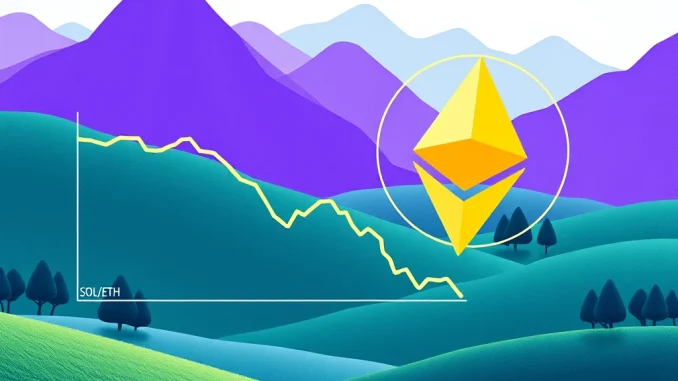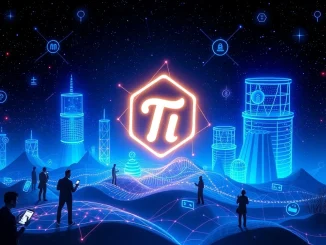
Are you watching the movements between Solana (SOL) and Ethereum (ETH)? A significant shift might be underway that could impact your portfolio. Recent SOL/ETH ratio analysis points to a critical junction, suggesting that Solana could face a substantial decline relative to Ethereum. This isn’t just market noise; it’s based on technical patterns and fundamental shifts highlighted by analysts.
Understanding the SOL/ETH Market Breakdown
What exactly is happening with the SOL/ETH ratio? According to reports, including one from Cointelegraph, this key cross-pair has broken below a significant technical structure known as a ‘rising wedge’ pattern. Think of a rising wedge as two converging trend lines, both sloping upwards. When the price breaks below the lower trend line of this pattern, it’s often interpreted by traders as a bearish signal, indicating potential downward movement.
In this specific instance, the breakdown from the rising wedge pattern on the SOL/ETH chart is particularly notable because it suggests a possible 40% decline in the ratio. This doesn’t necessarily mean Solana’s USD price will drop by 40%, but rather that its value relative to Ethereum’s value could decrease by that much.
Several factors appear to be contributing to this bearish outlook:
- Technical Pattern Breakdown: The clear break below the rising wedge’s support line is a strong technical indicator for traders.
- Solana Revenue Drop: A recent decrease in revenue generated on the Solana network, particularly from the memecoin frenzy, suggests a potential cooling off or shift in network activity and value capture.
- Ethereum L2 Competition: The growing strength and adoption of Ethereum’s layer-2 scaling solutions (Ethereum L2) are creating a more competitive environment for other layer-1 blockchains like Solana.
Why is Ethereum L2 Growth a Challenge for Solana?
Standard Chartered recently highlighted the increasing competitiveness of the Ethereum L2 ecosystem as a factor that could lead to Solana underperforming Ethereum. Why is this the case?
Ethereum’s layer-2 networks, such as Arbitrum, Optimism, Polygon (in its L2 iterations), and others, are designed to process transactions off the main Ethereum chain (layer 1), significantly reducing costs and increasing speed. As these L2s mature, they are attracting more users, developers, and capital.
Here’s how the rise of Ethereum L2 impacts Solana:
- Reduced Need for Alternatives: As Ethereum scales effectively via L2s, users looking for faster, cheaper transactions have less incentive to move to alternative layer-1 chains like Solana.
- Developer Attraction: The network effect of Ethereum, combined with L2 scaling, continues to make it a primary hub for decentralized application (dApp) development.
- Liquidity Fragmentation: While L2s can fragment liquidity initially, bridges and cross-chain solutions are improving, keeping capital within the broader Ethereum ecosystem.
Solana’s appeal has often been its high speed and low transaction costs compared to Ethereum’s layer 1. However, with L2s closing that gap, Solana’s unique selling proposition faces stronger competition.
What Does a Potential 40% Decline in the Ratio Mean for Investors?
A potential 40% decline in the SOL/ETH ratio doesn’t mean SOL’s price will drop by 40% in USD terms. It means that if ETH’s price remains constant, SOL’s price could drop by 40%. More realistically, it implies that over a given period, SOL’s performance in USD terms might lag significantly behind ETH’s performance.
For example, if the ratio is currently 0.05 (meaning 1 SOL is worth 0.05 ETH), a 40% decline would bring the ratio down to 0.03 (0.05 * 0.6). If ETH were trading at $3,000, SOL would theoretically be worth $150 at the start (0.05 * $3000). After a 40% ratio decline, with ETH still at $3,000, SOL would be worth $90 (0.03 * $3000). This represents a $60 drop in SOL’s USD price, which is indeed a 40% drop *if ETH stays constant*.
However, if ETH also increases in value, say to $4,000, and the ratio drops to 0.03, SOL would be worth $120 (0.03 * $4000). In this scenario, SOL’s USD price only dropped by $30 from the initial $150, while the ratio still fell by 40%. The key takeaway is that SOL is expected to underperform ETH significantly.
Actionable Insights for Crypto Analysis
Given this crypto analysis, what should investors consider?
- Monitor the Ratio: Keep a close eye on the SOL/ETH chart. Further breakdown or consolidation could provide more clues.
- Assess Risk: If you hold both SOL and ETH, understand the potential relative performance difference. This analysis suggests a tilt towards ETH might be warranted if the pattern plays out.
- Diversification: This serves as a reminder of the importance of not being overly concentrated in a single asset or ecosystem.
- Evaluate Fundamentals: Look beyond the chart. Is Solana developing new revenue streams? Are the L2s truly pulling significant activity away from Solana?
A potential market breakdown like this requires careful consideration. It’s not a guarantee, but a signal based on technical and fundamental factors that traders and investors should acknowledge.
Conclusion: Navigating Potential Headwinds
The breakdown in the SOL/ETH ratio, coupled with factors like decreased memecoin revenue and rising Ethereum L2 competition, presents a challenging picture for Solana’s relative performance against Ethereum. While technical analysis patterns like the rising wedge breakdown aren’t foolproof, they offer valuable insights into potential future price movements. The warning from Standard Chartered underscores the increasing pressure Solana faces from a scaling Ethereum ecosystem.
Investors should consider this analysis as part of their broader market research. Understanding the dynamics between major assets like SOL and ETH, and the competitive landscape shaped by developments like Ethereum L2 growth, is crucial for navigating the crypto market. The potential for a significant relative decline means vigilance and careful portfolio management are advised.
Remember, the crypto market is volatile, and outcomes are never certain. However, paying attention to signals like the SOL/ETH ratio breakdown and underlying fundamental shifts can help inform more strategic decisions.



